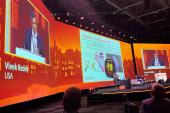Large Study Affirms Safety of Pulsed-Field Ablation, Reveals Some Rare Complications
The findings apply to the most commonly used PFA catheter in Europe, and safety might differ with other technologies.

PHILADELPHIA, PA—In the largest study of pulsed-field ablation (PFA) for the treatment of atrial fibrillation (AF) to date, rates of major complications were low and safety events were in keeping with the expected tissue specificity of this technology, according to results from the MANIFEST-17K study.
The data were presented here at the American Heart Association 2023 Scientific Sessions.
None of the more than 17,000 patients treated after European approval of the Farawave pentaspline PFA catheter (Boston Scientific) developed atrio-esophageal fistula, pulmonary vein stenosis, or persistent phrenic nerve injury, and there was a very low rate of phrenic nerve palsy that resolved by discharge (0.06%), Vivek Reddy, MD (Icahn School of Medicine at Mount Sinai, New York, NY), reported.
But some potentially serious complications occurred, albeit rarely, he noted. Coronary spasm, mostly related to ablations near the coronary arteries, was recorded in 0.14% of cases, and hemolysis-related acute renal failure requiring hemodialysis—which has not previously been reported with PFA—was seen in five patients (0.03%).
The latter “was rare and potentially manageable by looking at the number of lesions one places, as well as simple things like saline hydration,” Reddy said.
Discussing the results after Reddy’s presentation, Kenneth Ellenbogen, MD (Virginia Commonwealth University, Richmond), credited the investigators with performing a study focused on potential complications with PFA, an area with much less data compared with complications associated with conventional thermal ablation technologies that have been used for decades.
The bottom line, he said, is that in a real-world experience involving a representative population of patients treated by a wide variety of operators, “PFA has a very low rate of complications and a very good safety profile.”
With a focus on complications, Ellenbogen said, the study “represents a real contribution for those of us who practice AF ablation.”
A Few ‘Unusual’ but Infrequent Complications
Thermal ablation—with either radiofrequency or cryoballoon catheters—doesn’t discriminate by tissue type, so there is the potential for damage to surrounding structures, including the esophagus, phrenic nerve, and pulmonary vein. There is evidence suggesting that PFA, which uses electroporation for ablation, is relatively specific for myocardial tissue, with the potential to limit such damage.
Previously, the retrospective MANIFEST-PF study of 1,758 patients treated with PFA in Europe showed no evidence of esophageal damage, pulmonary vein stenosis, or phrenic nerve paralysis, with a low rate of transient phrenic nerve paresis (0.46%).
But “certainly there may be other unknown complications that we’ll only see after thousands of patients are treated,” Reddy said, pointing to the emergence of reports of atrio-esophageal fistula associated with cryoballoon ablation only after enough cases were completed.
Thus, the purpose of this new study was to both assess the preferentiality of PFA for myocardial tissue and to look for any rare adverse events. For the MANIFEST-17K study, investigators reached out to all 116 centers (one in Israel and the rest in Europe) performing PFA using the Farawave catheter after regulatory approval, and ultimately, 106 provided data. That included the 24 original MANIFEST-PF sites and 82 new sites.
After excluding the patients included in the MANIFEST-PF study, the researchers examined data on 17,642 patients (mean age 64 years; 34.7% women). Most (57.8%) had paroxysmal AF and 35.2% had persistent AF, with the remainder treated for long-standing persistent AF or atrial flutter or tachycardia.
Adverse events deemed related to the pulsed-field energy itself were infrequent, with no esophageal events, pulmonary vein stenosis, or phrenic nerve paralysis and 11 cases of transient phrenic nerve palsy that resolved by discharge. Other types of adverse events were uncommon, as well, with a 2.20% rate of minor vascular complications, a 0.36% rate of pericardial tamponade (mostly managed percutaneously), and a 0.30% rate of major vascular complications requiring intervention.
Five patients (0.03%) died, with two deemed related to the procedure (from pericardial tamponade and cardiogenic shock in a patient with cardiomyopathy and decompensated heart failure) and three not related to the procedure (one unexplained sudden death 9 days after ablation, one ventricular fibrillation (VF) arrest 3 days after ablation in a patient with severe three-vessel CAD, and one case of sepsis 30 days after ablation).
There were, however, two “unusual” but infrequent adverse events that occurred, including 25 cases of coronary spasm and five cases of hemolysis-related acute renal failure requiring hemodialysis and hospitalization, Reddy reported.
Most of the spasms (88%) occurred when PFA was being performed adjacent to the coronary artery, with the remaining generalized cases occurring when ablation was performed away from the artery. ECG changes were seen in 92% of cases, with 20% associated with hypotension. Two cases each were accompanied by chest pain and VF, but none resulted in MI and there were no known permanent effects, Reddy said.
The rate of coronary spasm compares favorably with what has been seen with thermal ablation, he said, adding, however, that “there are potentially serious implications.” The occurrence of ventricular fibrillation in a few cases of overt spasm warrants further study, he said.
As for the patients who developed hemolysis-related acute renal failure, all had persistent AF with normal or mildly elevated creatinine at baseline. The PFA lesion set was complex, with an average of 143 lesions applied per procedure. All patients had an improvement in renal function with hemodialysis by discharge, and function normalized in all patients during follow-up.
Some Question Marks
Reddy pointed out that the study was limited in that it was a retrospective analysis of center-level data and not a formal registry, there was no systematic use of imaging to look for pulmonary vein stenosis, and there was only one PFA device included. There may be differences among PFA devices, so safety of others should not be assumed based on these findings, Reddy said.
Nonetheless, the study is an important contribution to the field, Ellenbogen indicated, noting that large-scale studies like this will be needed before PFA becomes more widely accepted. He, too, pointed to the limitations of the analysis, but pointed out that this is largest experience yet reported for PFA that includes many operators and centers with varying levels of experience with AF ablation.
Phrenic nerve injury occurs, but it appears to be transient and resolves by discharge, he noted, adding that the lack of atrio-esophageal fistula in the study is “somewhat reassuring.”
The coronary spasm rate was “relatively low,” but nevertheless, Ellenbogen said, “it’s real and it can cause VF, so you better be awake and pay attention to it.”
The occurrence of a handful of cases of hemolysis-related acute renal failure “a big question mark” he said. “I’m not sure what this means, but it does appear that it is related to giving lots of lesions.”
Taken together, the findings show that “the risk of major adverse events was relatively low,” Ellenbogen said. “You can tell your patients, with this technology, the risk of a major adverse event is less than 1%.”
Todd Neale is the Associate News Editor for TCTMD and a Senior Medical Journalist. He got his start in journalism at …
Read Full BioSources
Reddy VY. Multinational survey on the safety of the postapproval clinical use of pulsed field ablation in 17,000+ patients (MANIFEST-17K). Presented at: AHA 2023. November 11, 2023. Philadelphia, PA.
Disclosures
- Reddy reports consulting for Abbott Vascular, AtriAN, Biosense Webster, Biostar Ventures, BioTel Heart – Philips, Biotronik, Boston Scientific, Cairdac, CardioFocus, Cardionomic, Coremap, Corvia Medical, Farapulse-Boston Scientific, Medtronic, Novartis, Novo Nordisk, Philips, Recor Medical, and W. L. Gore & Associates; holding stock options in Ablacon, Acutus Medical, Affera, Anumana, APN Health, Aquaheart, Autonomix, Axon Therapies, Backbeat, Biosig, Cardiocare – Israel, CardioNXT/AFTx, Circa Scientific, Corisma, Dinova-Hangzhou DiNovA EP Technology, East End Medical, EP Dynamics, EP Frontiers, EpiEP, Epix Therapeutics, Eximo, Field Medical, Fire1, Focused Therapeutics, Heart Repair Technologies, Impulse Dynamics, Intershunt, Javelin, Kardium, Keystone Heart, Laminar, LuxMed, Medlumics, Middlepeak, Neutrace, Nuvera, Oracle Health, Pulse Biosciences, Restore Medical, Sirona Medical, and Valcare; and having stock in Affera, Biostar Ventures, Farapulse-Boston Scientific, Manual Surgical Sciences, Newpace, Nyra Medical, SoundCath, Surecor, Vizaramed.
- Ellenbogen reports consulting for Abbott, Biosense Webster, Biotronik, Boston Scientific, and Medtronic.





Comments